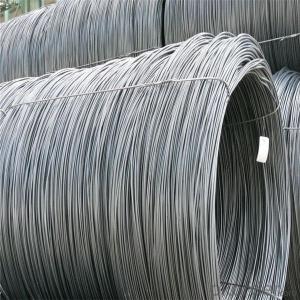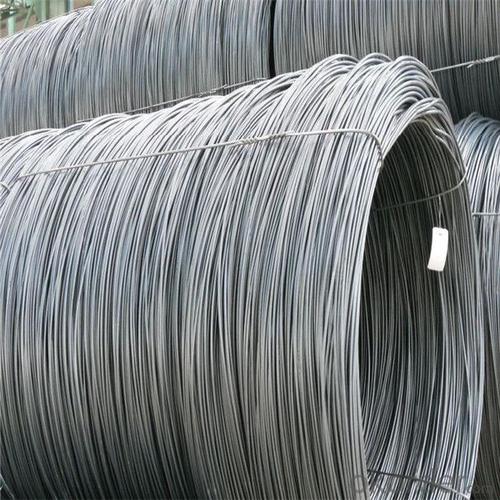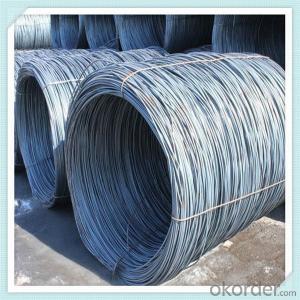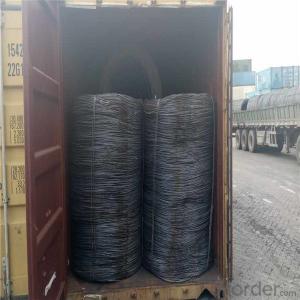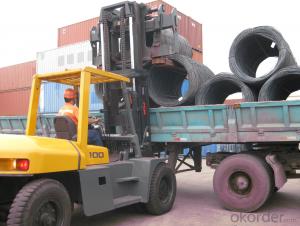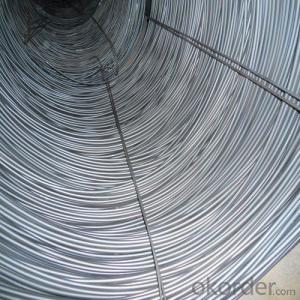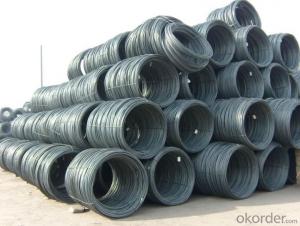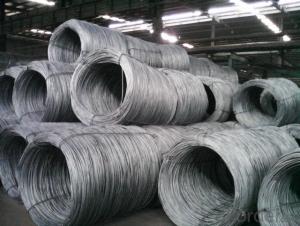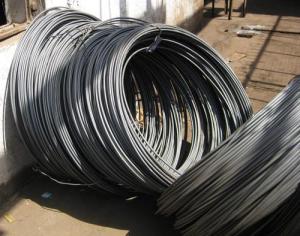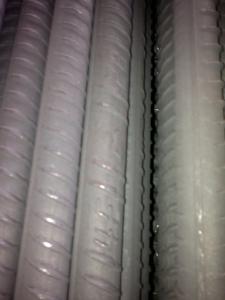Steel wire rod high quality sae1006 10mm low carbon
- Loading Port:
- Tianjin
- Payment Terms:
- TT OR LC
- Min Order Qty:
- 50 m.t.
- Supply Capability:
- 14621 m.t./month
OKorder Service Pledge
OKorder Financial Service
You Might Also Like
Specification
Steel wire is mainly used for prestressed and posttensioning technology in various
shapes of prestressed concrete structures,and widely used for civil engineering
construction, such as large scale railroad, highway bridges, building trusses,
overhead crane beams, industrial and prefabricated concrete floor, wall board,
tubular piles, PC water pipes, TV towers and nuclear power station, ETC.
Mainly used in building and construction as binding wire, tie wire and baling wire; also can be
make for wire mesh.
Our Advantage: High quality steel products from 1 class mills in
Reasonable price
Professionalism of the products
On-time delivery
Complete documents and certificates
Sincere service to meet our clients' requirements
Product Description :
Standard | AISI, ASTM, BS, DIN, GB, JIS |
Material/steel grade | Q195-Q235,SAE1006B,SAE1006CR, SAE1008B, SAE1008CR, SAE1010B, SAE1018B, or according to customers requirements |
Wire Gauge | 5.5-12mm |
Coil weight | 1.8-2.1mts |
MOQ | 25MT |
Delivery Time | 15-30 days after receipt of L/C or deposit by T/T |
Packing | In coil and load in container, if large quantity, by bulk vessel; Can be packed as customers' special requirements |
Payment terms | 1).100% irrevocable L/C at sight. 2).30% T/T prepaid and the balance against the copy of B/L. 3).30% T/T prepaid and the balance against L/C |
Application | widely used in machinery parts, manufacturing industry, electronics industry, metal tools and others |
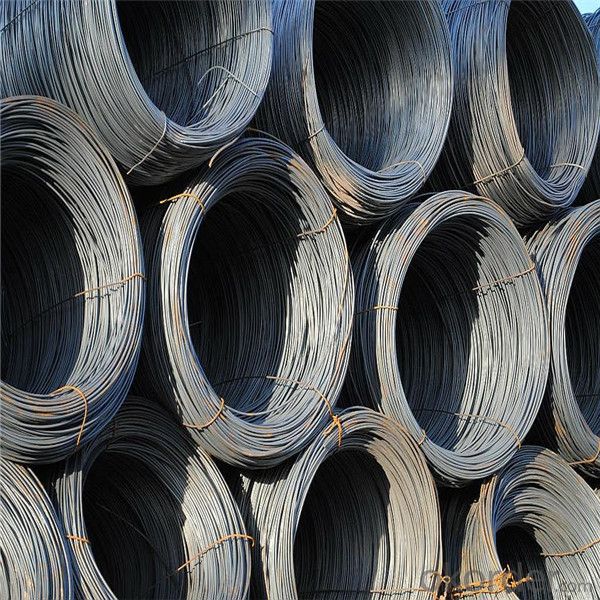
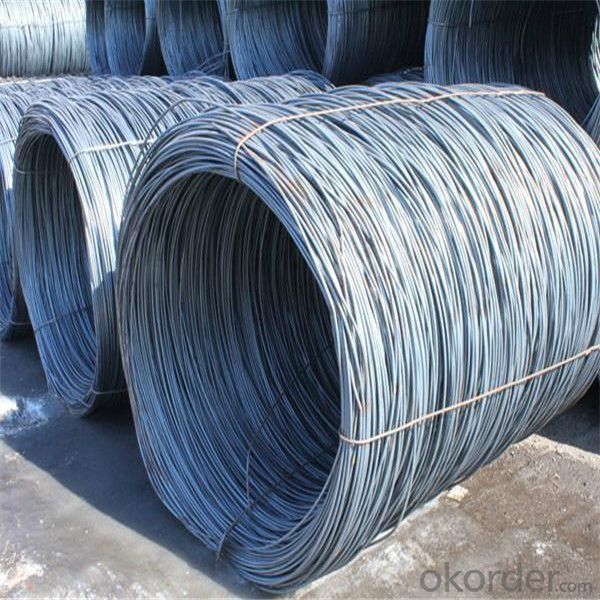

Application :
It generally used in braiding the hose for bathing product and machinery. With it
good flexibility, resistant to high temperature and resistant to corrosion, it
used widely in many industries.
Packing :
Hot-rolled wire rod is held in a unit with at least four steel straps in the
transverse direction and transported and stored without further packaging.
Before
the steel strapping is applied, the wire rod must be sufficiently compressed.
The strapping is fixed in the transverse direction with a single circumferential
strap so that the strapping does not slip and cause the coil to come apart.
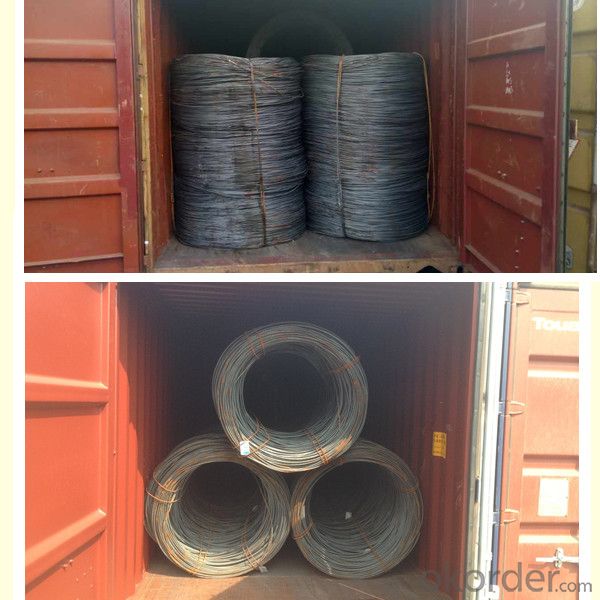
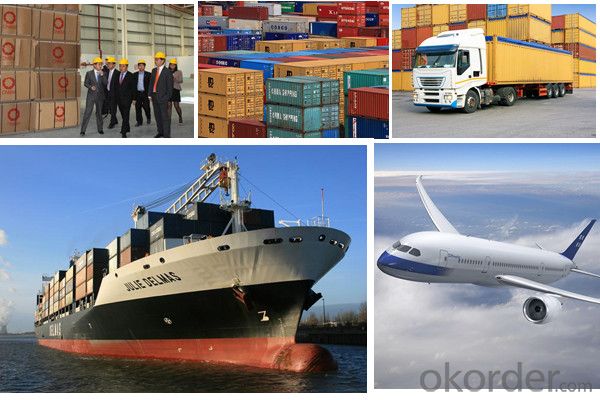
Our service:
(1) We cooperate with famous factories with advanced equipment and well trained workers.
(2) We can provide factory price with trading company service.
(3) We continuously work on the improvement of our processes, guaranteeing
consistently high standards of quality to keep none compensation.
(4) We guarantee 24 hours response and 48 hours solution providing service.
(5) We accept small order quantity before formal cooperation.
(6) We deliver the agreed quality at the agreed time, reacting to changes in
customer wishes in a flexible way.
(7) Due to our volume and selling power, we have excellent freight rates with
shipping lines.
(8) We strive to always be fair and honest in our dealings with customers.
(9) We strive to work together with customers to achieve much more than we can
achieve alone.
(10) Through our passion and commitment we aim to be a market leader in all our
key markets. To maintain our position as market leader we must continue to add
value in all that we do.
FAQ:
1.Q: What's your MOQ(minimum order quantity)?
A: One full container, mixed acceptable .
2. Q: What's your packing methods?
A: Packed in bundle or bulk ..
3. Q: How can I buy CNBM products in my country?
A:Please send us an inquiry or email ,we will reply to you if there is distributor in your country
4. Q: Can we visit your factory?
A: Warmly welcome. Once we have your schedule, we will arrange the
professional sales team to follow up your case.
5. Q: How long does it take to get the product if i place an order?
A:With the process of your requirements,we will pack and deliver in 3
-7 days. If it is by sea shipment,it will take 15-45 days depending on different locations
- Q: How is the surface finish of steel wire rod determined?
- The surface finish of steel wire rod is determined through a combination of manufacturing processes and quality control measures. First, the steel wire rod is produced through a hot rolling process, where the steel is heated and passed through a series of rollers to achieve the desired shape and thickness. During this rolling process, the surface of the steel wire rod can develop imperfections such as scale, which is a layer of oxide that forms on the surface due to the high temperatures involved. To remove this scale and improve the surface finish, the steel wire rod may undergo a descaling process, which involves methods like acid pickling or mechanical descaling. After descaling, the steel wire rod may undergo further processes like cold drawing or heat treatment to achieve the desired mechanical properties. These additional processes can also contribute to improving the surface finish of the steel wire rod. To ensure the desired surface finish is achieved, quality control measures are implemented throughout the manufacturing process. This includes regular inspections and testing of the steel wire rod to detect any surface defects or imperfections. Various techniques such as visual inspection, ultrasonic testing, and surface profilometry can be used to evaluate the surface finish and ensure it meets the required standards. In conclusion, the surface finish of steel wire rod is determined through a combination of manufacturing processes such as rolling, descaling, cold drawing, and heat treatment. Quality control measures are also implemented to inspect and test the surface finish, ensuring it meets the desired standards.
- Q: What are the common packaging methods for steel wire rod?
- The common packaging methods for steel wire rod include coiling the rod into large coils, bundling the rod into smaller bundles, or spooling the rod onto a reel.
- Q: How is the corrosion resistance of steel wire rod evaluated?
- Various methods and tests are utilized to assess the corrosion resistance of steel wire rod. One commonly employed technique is the salt spray test, which is also known as the ASTM B117 test. During this test, the steel wire rod is exposed to a controlled environment of saltwater spray for a specific duration. Subsequently, the wire rod is inspected for any indications of corrosion, such as rust or discoloration. Another approach employed to evaluate corrosion resistance is the electrochemical test, such as the measurement of polarization curves. This test entails immersing the steel wire rod in an electrolyte solution and administering a small electric current. The resultant polarization curve provides information regarding the rate of corrosion and the propensity of the wire rod to corrode. Moreover, visual inspection and microscopic examination of the wire rod's surface can be conducted to identify any signs of corrosion, such as pitting or surface roughness. These evaluations are often supported by various corrosion measurement techniques, including analysis of weight loss, measurement of corrosion potential, and determination of corrosion rate. To summarize, the corrosion resistance of steel wire rod is evaluated through salt spray tests, electrochemical tests, visual inspection, and microscopic examination. These evaluations furnish valuable information about the wire rod's capacity to withstand corrosion and ensure its suitability for diverse applications.
- Q: How is steel wire rod used in the manufacturing of wire rope decking?
- Steel wire rod is used as the primary material in the manufacturing of wire rope decking. It is typically formed into strands of wire rope that are then woven or twisted together to create a strong and durable decking material. The steel wire rod provides the necessary strength, flexibility, and resistance to corrosion, making it ideal for supporting heavy loads and ensuring the safety of the decking structure.
- Q: What are the common welding techniques for steel wire rod?
- There are several common welding techniques used for steel wire rods, depending on the specific application and desired outcome. Some of the most commonly used techniques include: 1. Gas Metal Arc Welding (GMAW): Also known as MIG (Metal Inert Gas) welding, this technique uses a consumable wire electrode and a shielding gas to create a weld. GMAW is commonly used for welding steel wire rods due to its versatility, ease of use, and ability to produce high-quality welds. 2. Gas Tungsten Arc Welding (GTAW): Also known as TIG (Tungsten Inert Gas) welding, this technique uses a non-consumable tungsten electrode and a shielding gas to create a weld. GTAW is often used for precision welding applications where a high level of control and a clean, aesthetically pleasing weld are required. 3. Flux-Cored Arc Welding (FCAW): This technique uses a tubular wire electrode with a flux-filled core. The flux provides a shielding gas and helps remove impurities from the weld zone. FCAW is commonly used for welding steel wire rods in outdoor or windy environments where the shielding gas from GMAW or GTAW may be compromised. 4. Shielded Metal Arc Welding (SMAW): Also known as stick welding, this technique uses a consumable electrode coated in flux. The flux creates a shielding gas and helps remove impurities from the weld zone. SMAW is a versatile and portable welding technique commonly used for steel wire rods in various applications. 5. Resistance Welding: This technique involves passing an electric current through the steel wire rods to create resistance and generate heat, which fuses the materials together. Resistance welding is commonly used for high-speed production welding of steel wire rods, such as in the manufacturing of wire mesh or fences. It is important to select the appropriate welding technique based on factors such as the type of steel wire rod, the desired strength and quality of the weld, the welding environment, and the available equipment and resources.
- Q: How is steel wire rod tested for straightness?
- Steel wire rod is tested for straightness using various methods. One common method is the visual inspection, where the rod is visually examined for any bends or curves. Another method is the use of a straightening machine, which applies pressure and force to straighten any bends in the wire rod. Additionally, specialized instruments such as straightness testers or laser-guided systems can be used to measure and verify the straightness of the steel wire rod accurately.
- Q: What are the various applications of steel wire rod?
- Steel wire rods have a wide range of applications across various industries. They are commonly used in the construction sector for reinforcing concrete structures such as buildings, bridges, and highways. Steel wire rods are also utilized in the manufacturing of automotive components, including springs, cables, and tires. Additionally, they find application in the production of wire mesh for fencing, as well as in the manufacturing of electrical wires and cables. Furthermore, steel wire rods are used in the production of various household items, such as kitchen utensils, furniture, and appliances.
- Q: What are the factors to consider when selecting steel wire rod for a specific application?
- When selecting steel wire rod for a specific application, several factors should be considered. Firstly, the desired strength and durability requirements of the application should be evaluated. This includes considering the tensile strength, yield strength, and ductility of the steel wire rod. Secondly, the corrosion resistance properties of the steel should be examined, especially if the application will be exposed to harsh or corrosive environments. Additionally, the size and diameter of the wire rod should be determined based on the specific needs of the application. Other factors to consider may include the cost, availability, and compatibility of the steel wire rod with the manufacturing processes involved in the application.
- Q: How is steel wire rod classified based on its diameter?
- Steel wire rod is categorized into different groups according to its diameter. The categorization is typically carried out using either a wire gauge system or by directly stating the diameter in millimeters. The wire gauge system assigns a numerical value to various wire diameters, with higher numbers indicating thinner wires. In the United States, for instance, the American Wire Gauge (AWG) system is commonly employed. In this system, the thickest wire is given the gauge number 0000 (four zeros), while the thinnest wire is assigned a gauge number of 40. Each gauge number corresponds to a specific range of diameters. On the other hand, steel wire rod can also be classified according to its diameter in millimeters. With this approach, the exact diameter of the wire rod is directly specified, allowing for a more precise classification. For instance, a wire rod with a diameter of 5.5 mm would be classified accordingly. Both classification methods offer a standardized means of categorizing steel wire rod based on its diameter. This information is crucial for various industries, including construction, automotive, and manufacturing, as it enables them to select the appropriate wire rod for their particular applications.
- Q: What are the common production processes for tin-coated steel wire rod?
- The common production processes for tin-coated steel wire rod include cleaning, pickling, drawing, coating, and annealing.
Send your message to us
Steel wire rod high quality sae1006 10mm low carbon
- Loading Port:
- Tianjin
- Payment Terms:
- TT OR LC
- Min Order Qty:
- 50 m.t.
- Supply Capability:
- 14621 m.t./month
OKorder Service Pledge
OKorder Financial Service
Similar products
Hot products
Hot Searches
Related keywords
